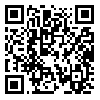BibTeX | RIS | EndNote | Medlars | ProCite | Reference Manager | RefWorks
Send citation to:
URL: http://jdm.tums.ac.ir/article-1-179-en.html
Background and Aim: Three Dimensional obturation of root canal is one of the main goals of root canal therapy to preserve health or reach the regeneration or healing of periapical tissues. Root end filling materials are used in numerous situations to reach the mentioned goals. One of the common root end- filling materials is mineral trioxide aggregate (MTA) which the foreign and Iranian ones are different in their prices. The aim of this study was to compare the rat connective tissue reaction to Iranian and foreign MTA.
Materials and Methods: This was an animal study in which 40 rats were divided into 5 groups of each 8. The polyethylene tubes filled with foreign (Pro Root MTA) and Iranian (Root MTA) white MTA and were implanted in subcutaneous connective tissue. Similarly, the empty tubes were inserted in subcutaneous connective tissue as control group. The samples were examined histologically after 7, 14, 30, 60 and 90 days and were scored as followings: 0, was characterized to samples without inflammatory cells without inflammatory reaction 1, for samples with less than 25 inflammatory cells mild inflammatory reaction. 2, for samples with 25 to 125 inflammatory cells moderate inflammatory reaction and 3, for ones with more than 125 inflammatory cells severe inflammatory reaction. The data were analyzed using Kruskal-Wallis test and p<0.05 was considered as the level of significance.
Results: In general, inflammatory reactions were reduced in all groups. Experimental groups had moderate to severe inflammation in the 7th day which had significant difference with the control group having mild to moderate inflammation (p=0.04). There was not any significant differences between experimental and control group in 14th, 30th, 60th and 90th days (p>0.05).
Conclusion: Based on the findings of this investigation, inflammatory subcutaneous connective tissue reaction to Iranian (Root MTA) and foreign (Pro Root MTA) MTA was the same.
Received: 2007/10/3 | Accepted: 2008/09/4 | Published: 2013/08/20
| Rights and Permissions | |
 |
This work is licensed under a Creative Commons Attribution-NonCommercial 4.0 International License. |




